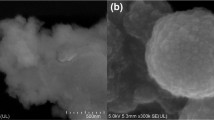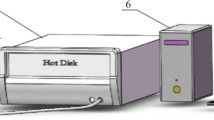Abstract
The undercooling degree of inorganic salt solution has great effect on the characteristic of phase change materials in cooling storage methods. Ammonium chloride solution was chosen as a kind of inorganic salt solution, and the experimental system was built to study the influence on supercooling degree of inorganic salt solution under the effection of concentration and porous media. The heat transfer enhancement method was studied by changing the concentration of inorganic salt solution and the diameter of pellets constituting the porous media. The experimental results show that with the increase in concentration, the value of inorganic salt solution’s supercooling degree and dispersion degree reduced, while the stability increased. The undercooling degree of the 15% ammonium chloride solution decreased by 17.5% compared to the 5% ammonium chloride solution. As the pellet diameter constituting the porous media decreased, the average value of the solution’s undercooling degree and dispersion degree also decreased, while the stability increased. The average value of the solution’s undercooling degree decreased by 21.7% when using 5-mm-diameter pellets compared to the ammonium chloride solution without porous media.







Similar content being viewed by others
References
Saman NG, Viktoria M, Justin NC. Phase equilibrium in the design of phase change materials for thermal energy storage: State-of-the-art. Renew Sustain Energy Rev. 2017;73:558–81.
Rathod MK, Banerjee J. Thermal stability of phase change materials used in latent energy storage systems: a review. Renew Sustain Energy Rev. 2013;18:246–58.
Sarier N, Onder E. Organic phase change materials and their textile applications: an overview. Thermochim Acta. 2012;540:7–60.
Tumirah K, Hussein MZ, Zulkarnain Z, et al. Nano-encapsulated organic phase change material based on copolymer nanocomposites for thermal energy storage. Energy. 2014;66(4):881–90.
Zhang N, Yuan Y, Cao X, Du Y, Zhang Z, Gui Y. Latent heat thermal energy storage systems with solid-liquid phase change materials: a review. Adv Eng Mater. 2018. https://doi.org/10.1002/adem.201700753.
Chen K, Hong R, Wu J, et al. Experimental research on low undercooling of ice storage and analysis of its energy saving. Energy Eng. 2015;01(013):52–5.
Pan L, Huang L, Yue Q, et al. Influence of vibration on the undercooling relex of inorganic salt solution as a phase change materials. J Zhejiang Univ Technol. 2008;36(06):655–8.
Hong H, Peck J, Kang C. Ice adhesion of an aqueous solution including a surfactant with stirring on cooling wall: ethylene glycol-a saline coupling agent aqueous solution. Int J Refrig Rev Int Du Frond. 2004;27(8):985–92.
Hong R, Sun ZH, Wu J, et al. An experimental study on reduce undercooling degree of ice storage solution using nucleation additive. J Zhejiang Univ (Eng Sci). 2005;39(11):1797–800.
Alimohammadi M, Aghli Y, Alavi ES, et al. Experimental investigation of the effects of using nano/phase change materials (NPCM) as coolant of electronic chipsets, under free and forced convection. Appl Therm Eng. 2016;111:271–9.
Ghossein RMA, Hossain MS, Khodadadi JM. Experimental determination of temperature-dependent thermal conductivity of solid eicosane-based silver nanostructure-enhanced phase change materials for thermal energy storage. Int J Heat Mass Transf. 2017;107:697–711.
He Y, Zhang N, Yuan Y, et al. Improvement of supercooling and thermal conductivity of the sodium acetate trihydrate for thermal energy storage with α-Fe2O3, as addictive. J Therm Anal Calorim. 2018;2:1–9.
Zeng JL, Zhou L, Zhang YF, et al. Effects of some nucleating agents on the supercooling of erythritol to be applied as phase change material. J Therm Anal Calorim. 2017;129(3):1291–9.
Hu Y, Jing D. Study on heat and mass transfer of porous media. Guangdong Chem Ind. 2006;33(11):44–7.
Py X, Olives R, Maura S. Paraffin/porous-graphite-matrix composite as a high and constant power thermal storage material. Int J Heat Mass Transf. 2001;32(44):2727–37.
Liu X, Jiang Y, Zhang S, et al. Melting process of porous- media-filled ice hold-over plate. Chem Ind Eng Prog. 2015;34(10):3636–43.
Siahpush A, O’brien J, C’repecu J. Phase change heat transfer enhancement using copper porous loam. J Heat Trasf. 2008;130:1–11.
Wu Z, Tao W. Analysis of heat transfer performance of metal matrix materials in the phase change thermal storage system. J Eng Thermophys. 2013;34(02):307–9.
Wang Z, Peng X, Wang B, et al. Experimental investigation of nucleate boiling phenomena in bead-packed structure. J Eng Thermophys. 2002;23(06):742–4.
Zhao Q, Zhang X, Liu T, et al. Undercooling of water and characteristics cold storage in bead-packed porous structure. CIESC J. 2015;66(01):426–32.
Zhang X, Liu T, Zhao Q, et al. Analysis of undercooling degree of water in ball-packed porous structure of different materials and diameters. CIESC J. 2015;66(06):2011–6.
Funding
Funding was provided by Shanghai Municipal Science and technology project (Grant No. 16040501600), Doctoral innovation fund of Shanghai Maritime Univeristy (Grant No. 2017ycx081).
Author information
Authors and Affiliations
Corresponding author
Rights and permissions
About this article
Cite this article
Xu, X., Zhang, X. Experimental investigation on inorganic salt solution’s undercooling degree under the action of porous media and different concentrations. J Therm Anal Calorim 135, 3241–3246 (2019). https://doi.org/10.1007/s10973-018-7526-y
Received:
Accepted:
Published:
Issue Date:
DOI: https://doi.org/10.1007/s10973-018-7526-y




